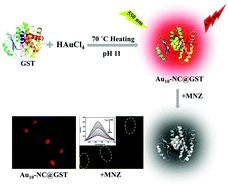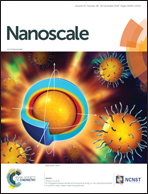Strong red-emitting gold nanoclusters protected by glutathione S-transferase†
Abstract
Glutathione S-transferase (GST) is distributed widely in tissues and has been proven to be vital in the body. For example, it catalyzes reduced glutathione (GSH) to a variety of electrophilic substances and thus protects cells against many toxic chemicals. Therefore, GST-related investigations have always been significant for medical and/or life sciences. In the present study, a new material of gold nanoclusters (Au-NCs) protected by GST, Au-NCs@GST, was fabricated via an improved one-step heating method. The products were fully characterized by X-ray photoelectron spectroscopy (XPS), transmission electron microscopy (TEM), matrix-assisted laser desorption/ionization time of flight mass spectrometry (MALDI-TOF MS), and Fourier transform infrared (FT-IR) and circular dichroism (CD) spectra. The results confirmed that around 10 gold atoms are encapsulated in one intact GST, forming Au-NCs@GST with strong (QY = 13.5%) red emission at 670 nm. Therefore, a new nanomaterial possessing both strong luminescence and bio-functions of GST was developed, and it has great potential in GST-related investigations. To prove the concept, Au-NCs@GST was successfully applied to detect metronidazole (MNZ) both in solution and in living cells. Therefore, in the present study, we report not only a new nanomaterial of Au-NCs@GST but also a feasible fluorescence probe for antibiotic detection. Both the improved synthetic method and the design concept can be extended to the fabrication of other kinds of metal nanoclusters using different functional proteins for various purposes.



 Please wait while we load your content...
Please wait while we load your content...